The Road To Pai, And a Surprise/Samsung BX2450 24″ LED-Backlit LCD Monitor, First Look

|
• Seascape Beach Resort • Tango Beach Resort • The Library • Villa Lawana Resort |
I have some unfortunate news to report on this project and total 100% transparency is how I feel this should be handled. My planned beneficiaries of this project, innocent very much in need children at a certain orphanage, have fallen victim to their local manager who we have found cannot currently be trusted and I doubt this is likely to change. Decisions need to be made if we're going to carry this project forward and if so who the new beneficiaries will be. I do expect this project to generate significant revenue so I take it very seriously. As you read this I'll be back in the Mae Sot area investigating further. I'll keep you informed. For now I'll still collect images with the intention of making the best most meaningful mosaics possible and as always, I'm asking for and will greatly appreciate your help with the images.
We are still accepting (and pleading for) images of children from SEA. No matter how terrible you think
they are, please send them in anyway. These images will be used to complete a set of 3 high quality mosaics which will be sold to benefit the Karen and Burmese Orphans living in the orphanages and refugee camps. The more images the better, I can
use all you have. Please take the time to go through your images for anything you think might help. If you missed the "No Place to Call Home" special, you can
click on the link and read more about this. Thank you! info@BangkokImages.com
Quick Click Links
Feature Photograph
The Road To Pai, And A Surprise Samsung BX2450 24" LED-Backlit LCD Monitor, A First Look
Photography News of Interest
Readers Submissions
Readers Questions A Snapshot of Bangkok Images Week in Review
Infocus Blog, Sub-30 and Dropping!T
Feature Photograph *menu

Canon 1ds Mark II, 24-70mm F2.8L USM, @F8 1/5th 35mm ISO 100
This image is from nearly 6 years ago at Angkor Vat. As one of my favorites it's printed and displayed on the wall in my apartment. On this specific wall there are two 20×24 inch prints, and four 11×14’s. This is printed at 11×14 inches. So what’s the big deal? Well, over the last few months I’ve watched numerous clients and visitors stop to carefully check out this one wall. It’s my “Angkor Vat” wall and some of my favorite images from Angkor Vat are on display.
What peaked my curiosity is that virtually every person spends more than a few minutes checking out the wall and the six images, and in most every case they finish with this print, as if they enjoy it the most. Once they tune into this image you can always watch their face go through a series of emotions and thoughts. Several have remarked “that’s a very powerful image.” Perhaps. But what I want to talk about is why I made this capture and what was involved.
Angkor Vat is a huge complex encompassing many temples and buildings and just as many outdoor scenes. I’ve spent weeks there, each day further refining my shot list. This image wasn’t on my shot list. I was walking through a dark temple late in the day right before the park was to be closed and was greeted by dark grey wall after dark grey wall. Several photography groups being led by workshop pros were guiding their group to take the more common aisle of door frames like the shot below. (sorry for the poor focus, but I never intended to use this shot and grabbed it in passing with no serious effort)

Canon 1ds Mark II, 24-70mm F2.8L USM @F8 8/10th 57mm ISO 100
If you can excuse the focus, you can see why this view is a workshop staple. Cascading door frames, directional light, and color at the end of the aisle. I’ve said before, if I wanted postcards I’d just buy some and save myself from lugging my gear around. I’ve also said before that when you see groups of photographers pointing their cameras in a certain direction, look in the opposite direction and it’s there where you’ll often find the much better composition. This day was a great example. Turning 180 degrees I saw my feature photograph.
I was tempted to move to the right and make the capture of the shrine, praying lady, AND the cascading doorframes. But it didn’t feel right. Motioning to my assistant for my tripod I quietly and quickly set up the tripod and mounted the camera, pulled out my Gossen light meter I use for such shots, and quickly adjusted the settings on my then new Canon 1ds Mark II in manual mode. Using an external shutter release cable, I then made the capture. Just one. Because I was using my personal light meter and because I was very familiar with how my light meter meters light.. I only took the one exposure.
I wanted ISO 100 for the best image quality, the perfect framing from the most powerful angle, and in my 24-70mm’s sweet spot for sharpness and the least possible distortion. I knew if I metered the light correctly the colors of the shrine would stand out and the graduations of light on the walls would be apparent. The reason I did this quickly is because we were at the time of day where the light was dropping fast. My first light meter reading taken before setting up, was a full stop different from the reading I took after setup and right before the exposure. The sun was falling that fast. I was also concerned the lady, who I considered an essential component of the composition would move or leave at any moment.
There are so many reasons I love this image. It’s full of color from the oranges in the shrine to the green moss on the wall, you get a feel of the ‘cascading doorframes’, graduated direction light, a lady in fervent prayer, and more than anything a glimpse of what is now a tourist attraction.. being used as it was meant to be used for centuries. No tourists. No modern anything. This image could have been captured hundreds of years ago and nothing in the composition would be out of place. It’s the one truly different image from that days shooting that you won’t find on a post card. And it helps that its technically correct.
I miss Angkor Vat. I’ll be going back early next year.
The Road To Pai, And A Surprise *menu
I’ve been waiting to visit the Mae Hong Son province for years. I’ve planned a half dozen trips to the province, all of which have been canceled for one reason or the other. This time I was determined to go. A perfect storm of circumstances colluded to make this happen. A friend was in Pai and promised to show me around, I hadn’t been on the road in months and I really needed some personal ‘road time’, and for the first time in 6-7 months I had the free time. I loaded up the truck with a week’s worth of clothes and gear and headed out. I made Chiang Mai the first day and enjoyed a nice stay at the Empress Hotel. After a great western breakfast I headed out of Chiang Mai on road 1095 bound for Pai.
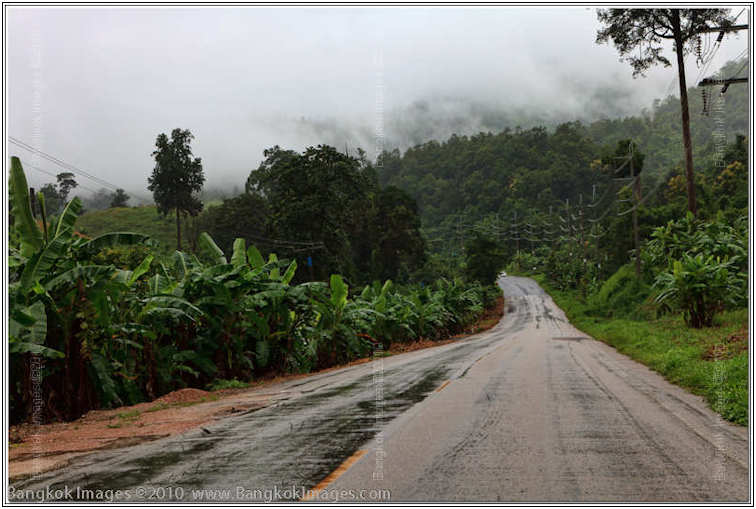
Canon 5d Mark II, 24-70mm F2.8L USM @F5.6 1/640th 55mm ISO 200
I was told the drive into Pai would only take 2-3 hours. This day it was raining hard and lightning strikes were happening all around me. The going was much slower than anticipated. Even though there weren’t many vehicles on the road, I still passed wreck after wreck. Most where the cars had just went off the road, but some where the cars rolled down mountainsides. There was very little drainage and the road was especially slippery. I slowed way down and crept along knowing my 2-3 hour trip would take me most of the day. My new goal was to arrive before dark.
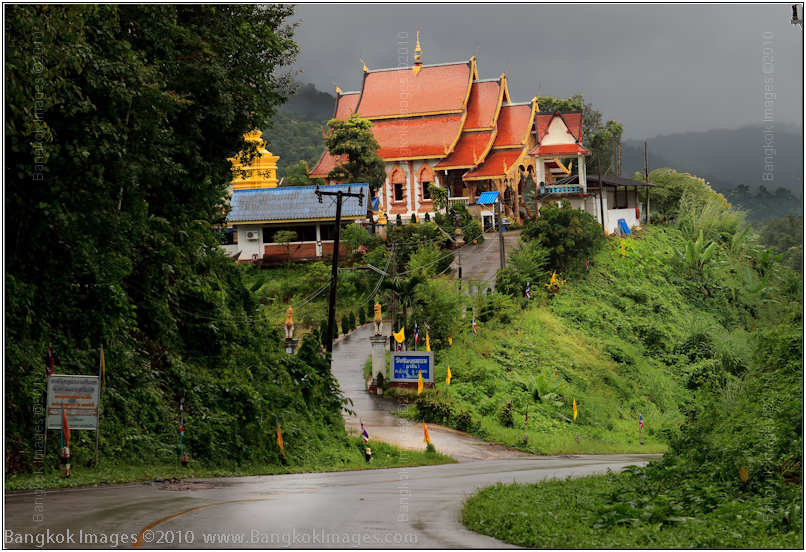
Canon 5d Mark II, 24-70mm F2.8L USM @F5.6 1/200th 70mm ISO 200
Even with the bad weather every other bend in the road treated me to a scene of beauty, or at least something unusual. The further along I got, the higher in elevation I climbed, and the more powerful the rain forest became. With the rain pouring down and lightning striking nearby tree tops I rounded a bend and was greeted with this view of the temple. I rolled the car to the stop and weighed the discomfort of becoming soaked and then sitting in the air conditioned cab for the next few hours, or not making the capture. I was only outside the truck for 2-3 minutes but it was enough for me and my gear to get totally soaked. I always travel with a stack of towels in the backseat, and I put them to good use on the gear first and me second.
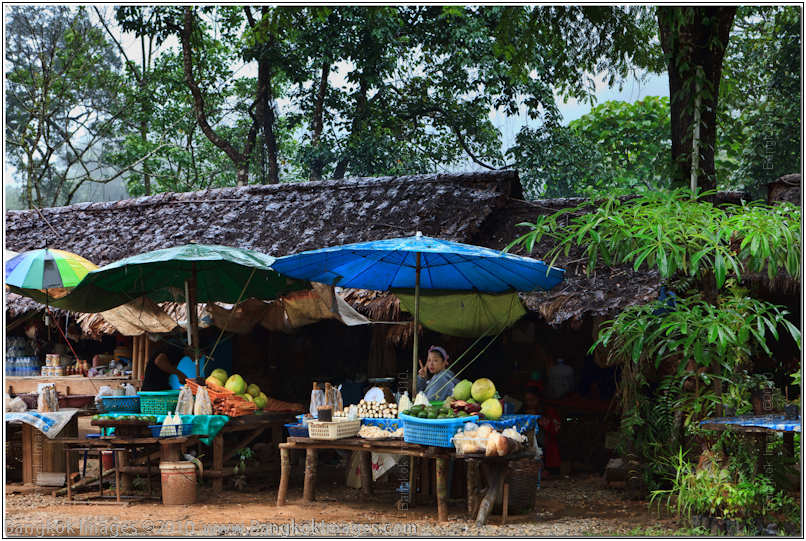
Canon 5d Mark II, 24-70mm F2.8L USM @F5.6 1/50th 70mm ISO 200
A few hours of beautiful forest later I started to approach the first major immigration control checkpoint and the small town that supported it. The rain had dwindled to a soft drizzle and the vendors were out in force selling their wares.
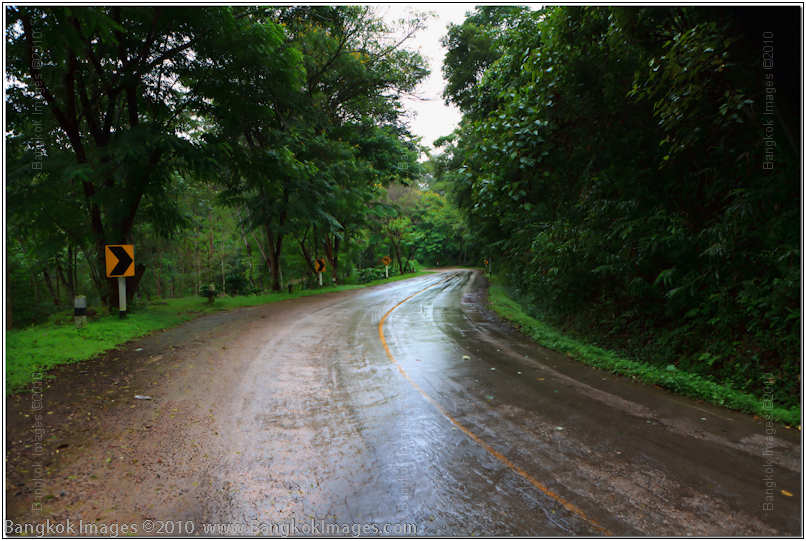
Canon 5d Mark II, 24-70mm F2.8L USM @F5.6 1/40th 24mm ISO 200
Your average road was full of slippery leaves, moss, and of course rain. Trees over hanged the road making for a really beautiful drive.
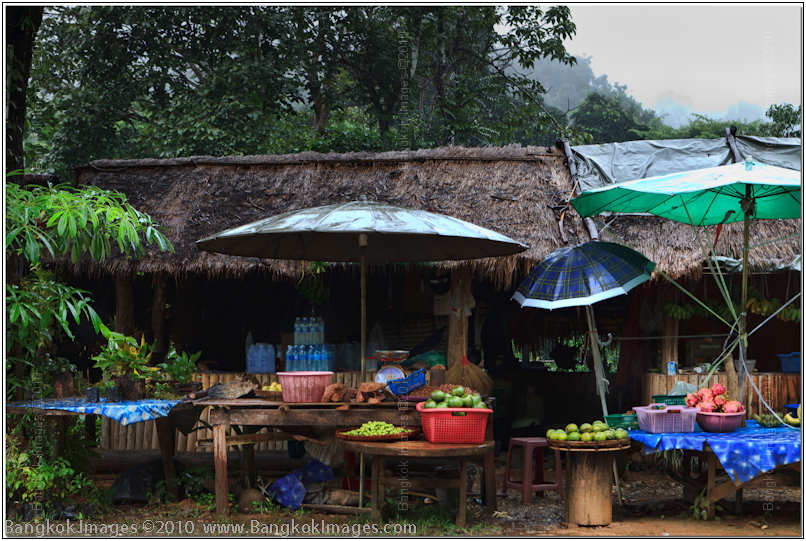
Canon 5d Mark II, 24-70mm F2.8L USM @F5.6 1/50th 70mm ISO 200
A bit further on, another town, another string of roadside vendors. Anyone who travels in Thailand quickly notices there might be 1001 small stands, but they’re all selling the same 10-20 items. Oddly enough they’re all the same price! I suppose they depend on the good Buddha to prompt someone to stop and buy.
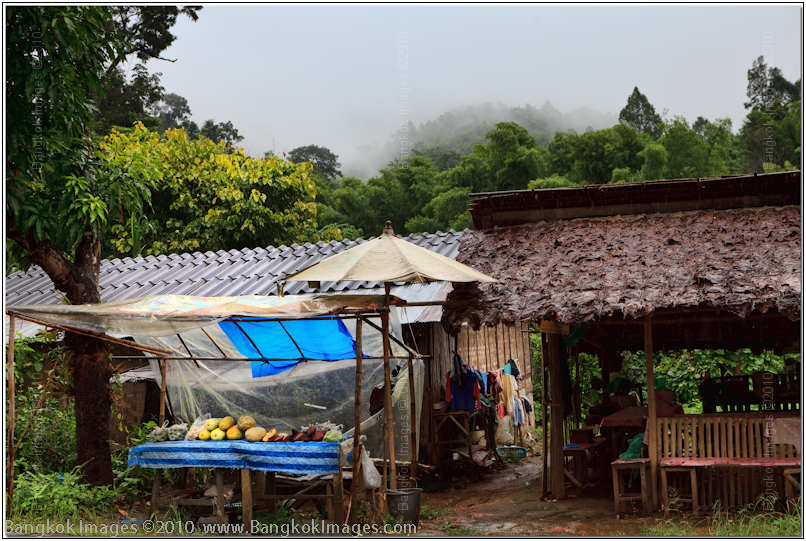
Canon 5d Mark II, 24-70mm F2.8L USM @F5.6 1/250th 43mm ISO 200
Notice the ‘mist’ rolling in over the hills? This is a solid sheet of water just a few minutes from pouring on top of us. This vendor was busy tying down her stand and securing what could be secured.
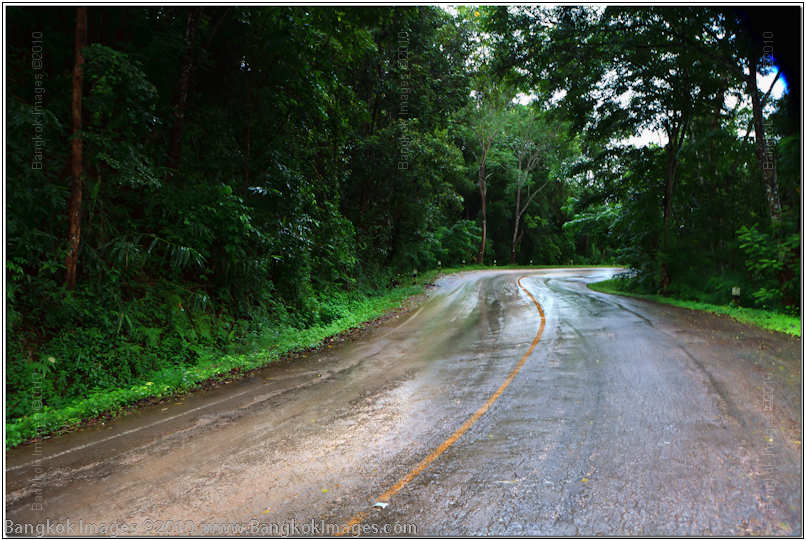
Canon 5d Mark II, 24-70mm F2.8L USM @F5.6 1/15th 24mm ISO 200
You could be forgiven for thinking the entire road looks the same, and in many ways it does. Yet the solitude and beauty blended together for a feeling not often felt in Thailand.

Canon 5d Mark II, 24-70mm F2.8L USM @F8 1/500th 38mm ISO 100
This vista was only 500 meters from the shot above. I’m sure I missed a great many of these as most were filled with banks of mist and clouds and you just couldn’t see them. But when the conditions allowed, you certainly were treated to a wonderful view.
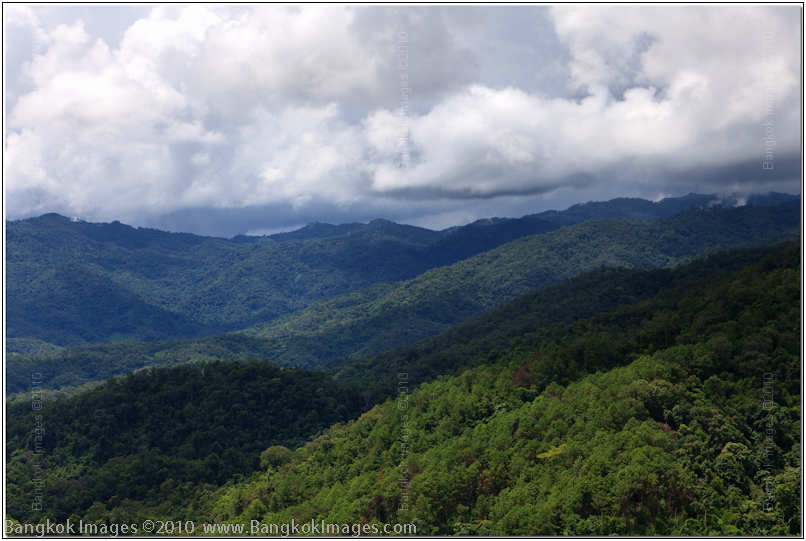
Canon 5d Mark II, 24-70mm F2.8L USM @F8 1/400th 70mm ISO 100
30 minutes later the rain let up just enough for another fine view. Gentle rolling hills amidst tall green forest covered mountains with huge banks of clouds rolling through at hundreds of kilometers an hour. The views were highly dynamic to say the least.
The Surprise!
On the way up from Chiang Mai I chatted on the phone with a friend catching up on this and that, and one of the subjects of discussion was my disappointment with the architecture of Thailand. Face it, 99% of the rural “structures” are nothing more than crude shacks made of the same cheap building materials void of any sense of style and in many cases designed utility. From the south to north, east to west, rural structures in Thailand have mostly been keenly disappointing to me. Heck, even the ‘stylish’ city homes build by the rich certainly aren’t influenced by Frank Lloyd Wright are they? It seems no matter how much money Thai’s have, they come up with the same sense of ugly.
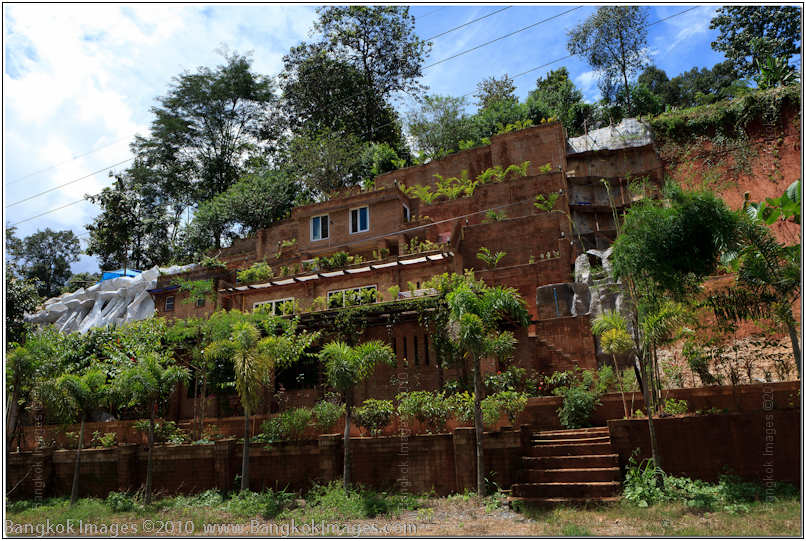
Canon 5d Mark II, 24-70mm F2.8L USM @F8 1/250th 24mm ISO 100
So imagine my surprise when rounding a bend in the hard driving rain when I see this unique structure literally built out of a solid rock faced cliff! Granted, it’s no award winner, but it was certainly unique enough to prompt me from my car in the heavy rain to take some snaps. And enough so that half of these (those with the blue sky) prompted me to stop on my return journey for some better quality images.
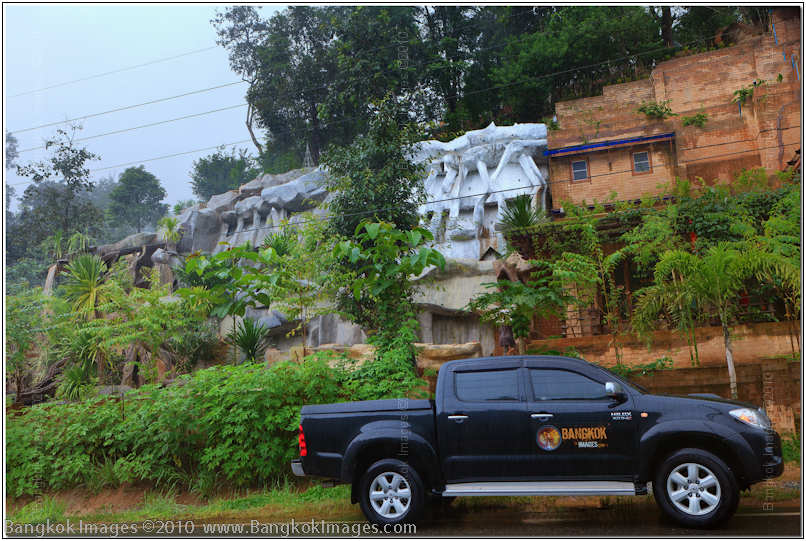
Canon 5d Mark II, 24-70mm F2.8L USM @F5.6 1/80th 28mm ISO 200
If you look closely you’ll see this is a solid rock cliff with supports drilled into the rock, framing attached, and then regular walls and rooms built on the framing. Oddly they didn’t hold the same style throughout the project which is typically Thai. It looks like they woke up on Monday and decided they wanted a traditional look, then woke up on Thursday and decided they wanted a wild look, and a week later saw something survivor on television so they changed to that style too.
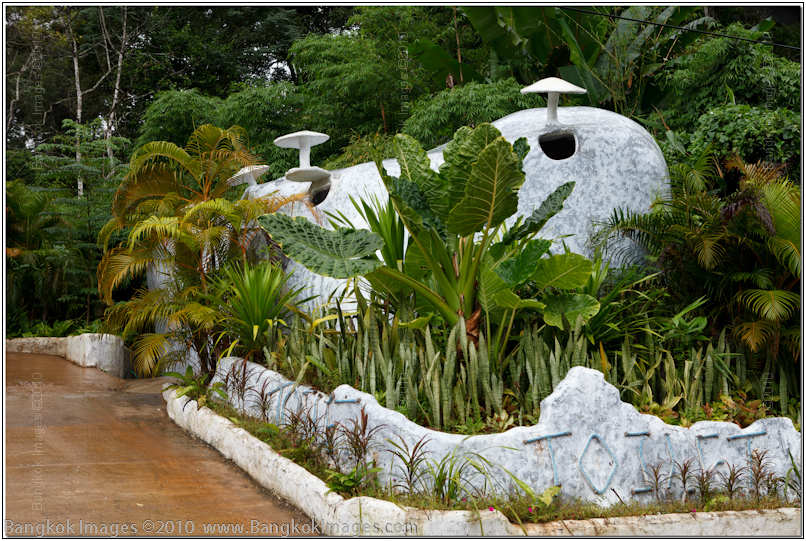
Canon 5d Mark II, 24-70mm F2.8L USM @F6.3 1/80th 48mm ISO 200
Can you guess what this structure is? It’s the public rest room. Notice the word “toilet” on the front wall face? This is a sort of guest house, coffee shop, theme park, wine tasting, whatever sort of place without a single customer or even a host to show me around. I wandered around for 30-40 minutes and didn’t see a sole. So no one could tell me why they needed a toilet off to the side of the property. I suspect there’s no toilets in the rooms. Which means if you need to go in the middle of the night, you’ve got quite a climb down some ladders and the such to use the toilet. Save your empty pop bottles!
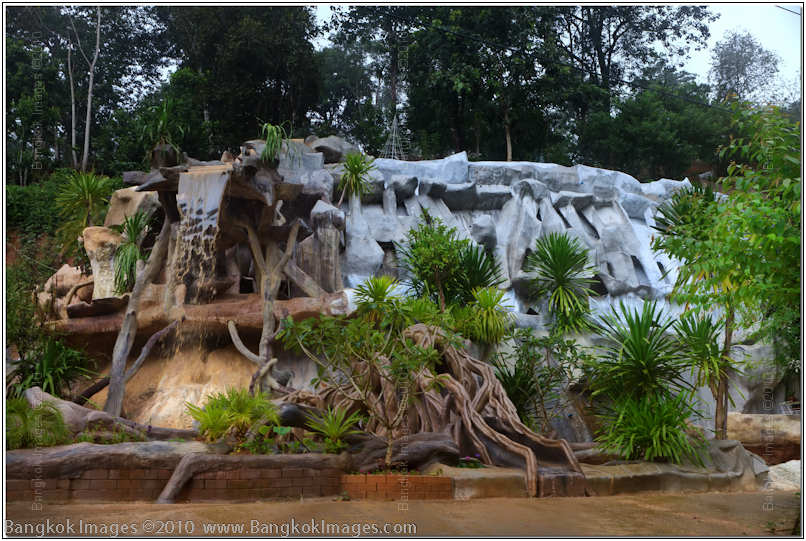
Canon 5d Mark II, 24-70mm F2.8L USM @F5.6 1/100th 38mm ISO 200
A fairly elaborate rain gutter system? Water comes from a stream above the property, runs across the roof of the structure, and then falls down this man made waterfall. It had tons of water when it was raining, no water on the way back when it wasn’t raining. So a rain gutter system?
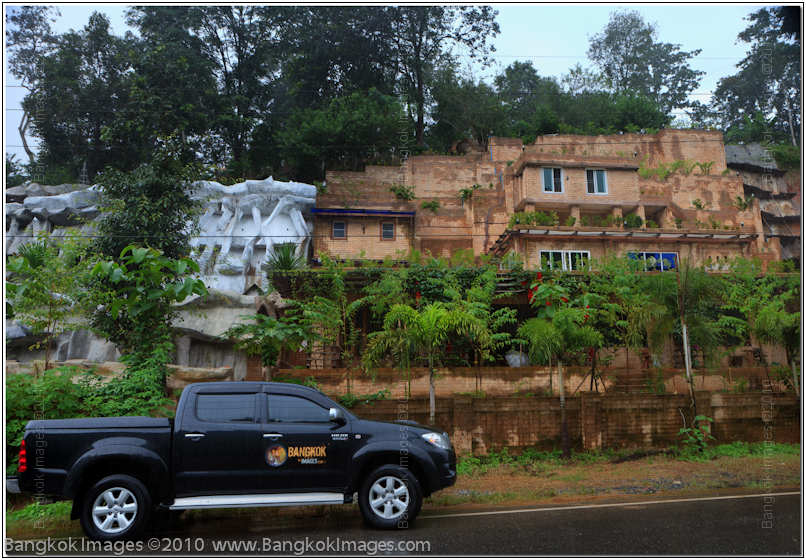
Canon 5d Mark II, 24-70mm F2.8L USM @F5.6 1/60th 24mm ISO 200
It really is a unique idea, and very different from the standard Thai rural shacks or even the more stylish Burmese leaf roofed huts you often see in the area. Notice to the very right of the frame some supports on the rock face which haven’t yet been enclosed?
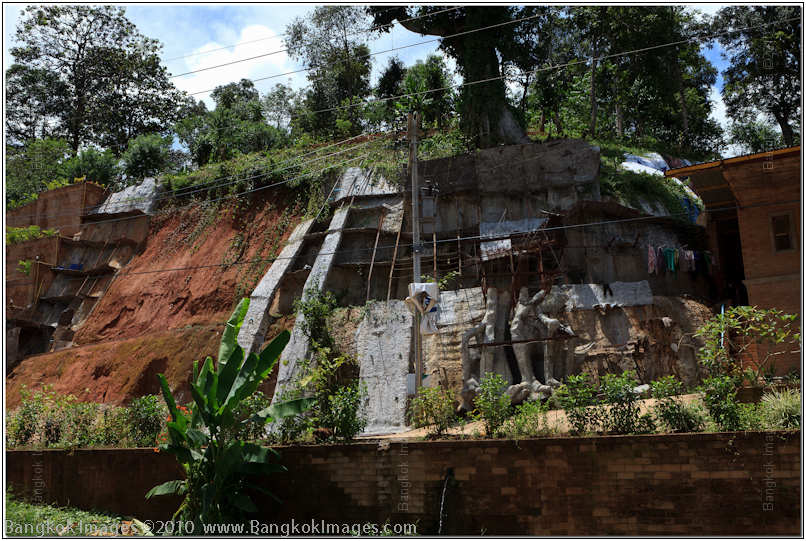
Canon 5d Mark II, 24-70mm F2.8L USM @F8 1/200th 35mm ISO 100
This is a new section being built so you can get a taste for their construction methods. Metal framing secured to the rock face, and then poured cement outer walls for this section. And the outside which frankly looks like a pile of bones. Very strange.
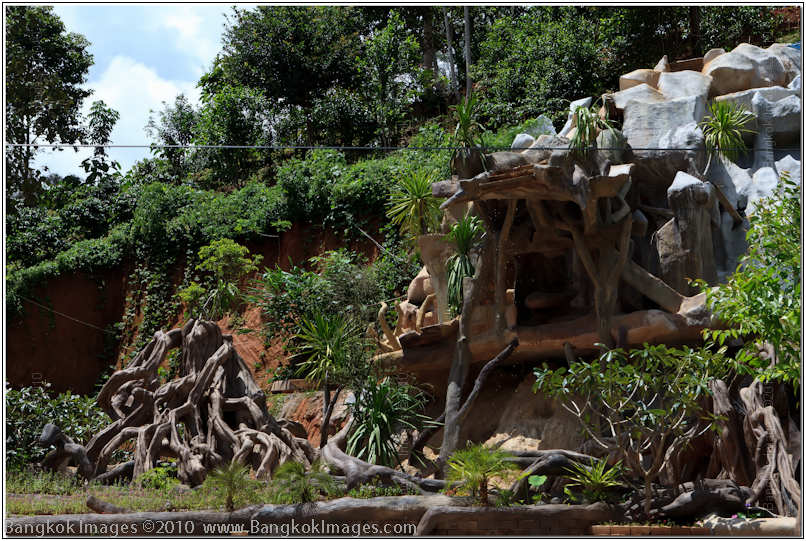
Canon 5d Mark II, 24-70mm F2.8L USM @F8 1/320th 57mm ISO 100
Nothing says high-end resort like fake cement logs in haphazard piles. This view looks more like the log mountain ride at Knotts Berry Farm than a guest house, but I suppose that’s what makes the place unique. You just know there’s no building codes or inspectors on this project..
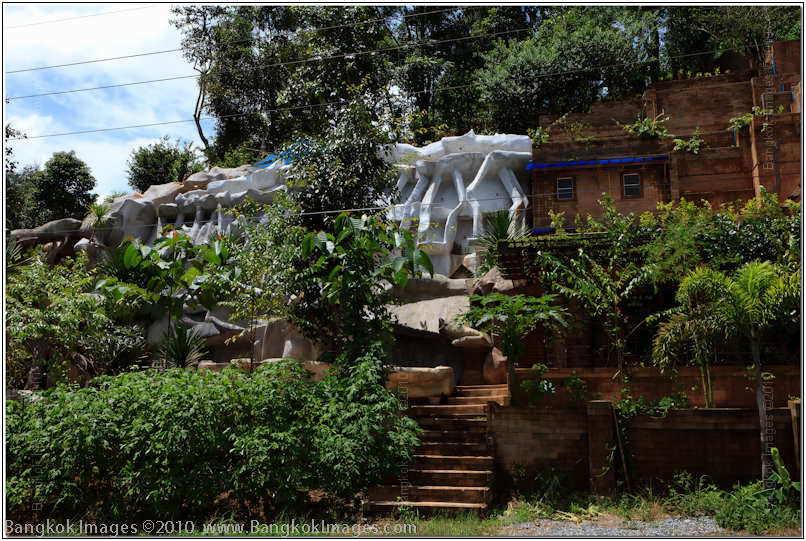
Canon 5d Mark II, 24-70mm F2.8L USM @F8 1/200th 34mm ISO 100
This is a more clear shot taken on my return trip. You walk up the steps to the lobby and coffee shop, not sure what the mess to the right of the building is all about, and still no one was there to answer any questions. It was really odd, the doors were open and you could even smell the coffee, but no one was home. I sat, read a magazine, waited, and after 30 minutes was back on the road again.
This just goes to show you Thailand never ceases to surprise.. J Really, I think this place has loads of potential and I really wanted to talk with the owners and learn more. It’s obviously not finished, so perhaps I’ve been a bit harsh in poking fun at them.
Next week we’ll take a look at the city of Pai itself. We still have the Lisou and Chinese villages, and the rural landscapes of the area as well. This was a trip well worth taking and I can’t wait to go back.
Samsung BX2450 24” LED-Backlit LCD Monitor, First Look *menu
Introduction
Monitors are a sensitive subject for many because they are often the most expensive component of a photographer's workstation and can create the most enjoyment, or give the most frustration of anything else out there. And I’ll be frank, most photographers really don’t understand enough about monitors to understand why to buy a certain type over another. I know this sounds condescending, but this isn’t my intent. My intent is to stress certain features and monitor types so you do understand why you buy a certain type of monitor over another.
In the coming weeks I’ll be reviewing this Samsung BX2450, and my workstation NEC LCD2690uxi2’s. There are many differences between the two, but the biggest functional difference is something I discuss below in my response to Rod about the benefits of your monitor having hardware LUT (look up table) capabilities, or being limited to video card LUT’s. Please read my response to Rod very carefully and consider your own needs before purchasing a monitor. In a nutshell, the NEC or other such high-end imaging monitor holds its own LUT. So, you can profile the monitor to as many different profile types as you need, and then change the profile as desired to match the work you’re doing at the time. Any other type of monitor runs off the video card LUT and limits you to only a single profile.
Only when you understand color profiling can you fully appreciate these differences, so next week our learning topic will concentrate on color profiling and why you would use one profile over the other, where the most common profiles are normally used, and their limitations. We’ll also once again go over profiling software and hardware colorimeters.
This First Look will assume you’ve decided to choose a video card LUT supported monitor either for economic or other reasons and we’ll approach our evaluation of this monitor based on those choices.
My Requirements
My personal reasons for selecting this monitor were my specific needs:
- A lightweight portable monitor I can take on the road and carry in my carry-on sized roll-around suitcase without taking much room. The size must fit in the carry-on, the weight must be under 10 pounds, preferably closer to 5.
- It must be able to be accurately profiled to a high degree (though not the highest) of color accuracy using a standard colorimeter and calibration software, and hold that setting during travel.
- The stand must detach without tools to make storage easy.
- The screen must be matte, or non-glare.
- Connectivity. This should be able to connect either of my laptops either through a digital DVI or HDMI port, or through an analog VGA port. As every new still and video camera now comes with an HDMI output, direct connection to the monitor was a must so I can review my images/footage without a computer.
- The cost must be under baht 10,000. I figure it will take severe abuse as a travel monitor and will eventually end up broken and needing to be replaced, so I didn’t want to have that much invested.
My Selection
I didn’t ask for much, did I? With this list of requirements in hand and a Thai speaking assistant to help with any written/verbal translations/interpreting, I headed to Pantip Plaza with ONLY baht 10,000 in my wallet. I was determined to walk the aisles of this hell on earth and not leave until I’ve forced myself to make the best choice available.
Many shops and several hours later I’d settled on the Samsung BX2450 24” Widescreen LED-Backlit LCD Monitor. Cost including a 3 year warranty was baht 8,900. It’s a 16:10 wide screen format with 1920x1080p resolution, 1000:1 contrast ratio (which means squat on any imaging monitor), and a 170 degree viewing angle. It also has a 2ms response time making this monitor very suitable for viewing sports or playing video games.

Physical Description
This monitor met all my requirements. The stand detaches easily and quickly with no tools. This allows the monitor to be slipped into a standard size pillow case for protection, and nestled in my carry-on between my pants and shirts with the stand being stuck in any available space. Because it’s an LED monitor the power requirements are very low (22 watts) which make the power transformer (brick) smaller than even the smallest laptop power supply. The cables are very slender and don’t take up much room either.

The monitor is less than 1 inch thick when the stand is removed. This makes it very slim indeed. It’s also very lightweight, I’d guess 5-6 pounds. It’s actually very stylish, easily moved or carried, and deceptively capable. Compared to my 48 pound 6” thick NEC LCD2690uxi2’s it’s almost invisible.
The screen is a non-glare matte finish backlit by LEDs vs. the common CCFL backlighting much more common in LCD screens CCFL’s are essentially very thin and small fluorescent bulbs. LEDs use very little power in comparison which means they also run much cooler and can be contained in much smaller housings.

Connectivity
Connectivity is ideal for my requirements. It has an analog VGA connector and comes with a light duty space saving cable. VGA outputs are very common on older notebooks and are still common on even the latest models. For instance, my new Lenovo x201s super lightweight computer only has a VGA output for a second monitor. My Dell Mobile Precision Workstation has both a VGA analog and a DVI digital output. Most desktop computers have a DVI digital output. The BX2450 comes with an HDMI to DVI cable for these systems. Some newer laptops, almost every new DSLR and video camera comes with an HDMI output, and the BX2450 allows direct connection via a HDMI to HDMI cable, usually supplied with your camera. With two HDMI ports you can have your computer and DSLR (or Playstation or many other HDMI compatible video devices) connected to the monitor at the same time and then switch back and forth between them. Perfect for my needs!

Internal Monitor Controls
The OSD (on screen display) is activated is a capacitive discharge touch type that uses the natural resistance of the human body to complete the circuit thereby ‘switching’ the function. This means there are no physical buttons, only a designated area to place your finger on the gloss black bezel. Over the years I’ve found my body has no natural resistance and I struggle with such devices and this was no exception. Everyone else who I asked to try the switches had no problem.
There are the standard on screen controls for brightness, contrast, red green and blue, and the standard controls like the sleep timer, resolution, modes, and so forth. There are also some unusual controls unique to this series of monitors called Magic Bright 3, Magic Eco, Magic Angle, and some other controls that mean nothing to someone who is going to calibrate/profile their monitor for imaging use. If you’re looking at this monitor for a general purpose computer monitor and/or for game play, the “Magic” controls adjust viewing angle, power consumption, and screen brightness automatically.
Performance
This is the clincher right? If it doesn’t present a sharp detailed image with accurate colors than it’s useless for imaging. I’m pleased to say it’s usable for imaging work. In fact, it’s even pleasant to use for imaging work inside the confines of the single profile you’ll have to choose from.
There is tons of brightness and contrast, to the order of 200-300% more than you’ll need for imaging. This is a very bright monitor with fairly accurate and vivid colors right out of the box. If I wasn’t using it for imaging I’d just be able to hook up the power and signal cables, turn it on, and press the “On” and “Automatic” buttons and not need to do anything else.
The first computer I connected it to was my small 2.5 pound Lenovo x201s ThinkPad. I connected it via its VGA output port, installed the driver via the included installation disk (this was very easy and took about two minutes) and the video driver of the laptop immediately recognized the second monitor and allowed me to set it up either as the main only monitor, a primary monitor, or an extended monitor.
Before profiling I set it to automatic and ran some Blue-Ray movies and was very pleased with its out of the box performance.
Next, I installed i1Display 2’s Imatch 3.62 software and connected the included colorimeter via a USB port. The monitor profiled very easily with the most difficult part being dealing with the capacitive discharge touch switches on the monitor itself. Frankly, I was surprised with the ease with which it profiled, producing a very acceptable profile on the first try. Often, you have to try several methods with a monitor to see which works best and to get to know the limits of your monitor. This wasn’t necessary with the Samsung BX2450.
Once profiled I put up some images in Adobe’s Lightroom 3.2 and the colors looked as they should for the type of profile I made.
Next, I connected it to my Dell Precision Mobile Workstation, a 17 inch powerhouse I use for workshops and large jobs away from home, and like the x201s it’s equipped with Windows 7 and uses the new color manager to assign profiles to each individual monitor. This laptop is one of the very few equipped with a DVI port and I connected it with the included HDMI to DVI cable. The profiling went just as smoothly as with the Lenovo x201s ThinkPad.
Of course because it uses the video card LUT, the internal monitor settings had to be changed which means each time I connect it to a different computer I need to go through the calibration process again. This is very limiting if you use the monitor with more than one computer.
Summary
I must admit, for an inexpensive monitor I’m impressed. For an LED back-lit monitor I’m impressed. Overall I’m impressed. It appears it will do the job I purchased it for and do so well. Still, with monitors you can’t really be 100% certain about their performance without either using them extensively or running them through a battery of tests and I prefer to use them in real life situations. For that reason I’ve called this a first look and I’ll update this into a review after 4-5 weeks when I’ve had a chance to really go over things.
Usually I’d just wait and do the full review, but I know there are quite a few of you out there who have been asking me about just such a monitor and wanted my opinion as soon as possible. At this time I’d have to say my impressions are very positive. However, until you read next week’s feature on color profiling, and know for sure what type of monitor (internal monitor LUT vs. external video card LUT) you might want to hold off until then.
The more expensive and the more serious use the equipment is, the more I like to use it before recommending it. This is the case with my pair of NEC LCD2690uxi2 monitors. I’m done reviewing them, but the write-up is either going to be very abbreviated, or exhaustive to cover everything. These are probably the best monitors available without totally busting the bank. I couldn’t be more happy with them and they fill my needs completely. I’ll finish out this monitor series with the NEC review.
Photography News of Interest *menu
How about a very cool hot shoe mounted EVF (electronic viewfinder) for your HD (live view) compatible DSLR to make it more ‘movie camera like’? Surely this will be popular with those using their DSLRs to make serious HD video. From Redrock Micro!

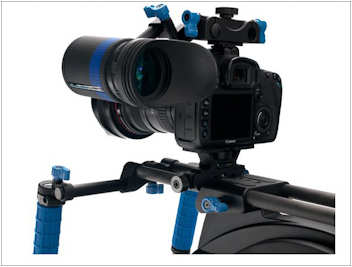
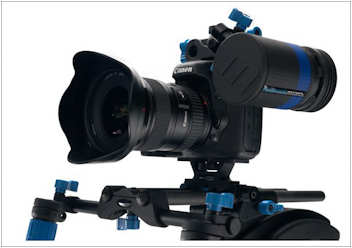
Cosina announces an adapter for the Sony NEX-5 which enables a mechanical connection to their lenses. Only lenses with a manual aperture ring will be full compatible.

The Sony NEX-5 has been well received by many including the professional community, but the menu structure has been heavily criticized by many. Sony responded with a firmware upgrade due
to be released in mid-October. The guys over at the Luminance Landscape have an early copy and they talk about the improvements.
Hazy Hippy Photography! Chris Steinback’s retro/vintage style will certainly entertain! A bit more fun than last weeks mega list of new gear eh?

Jannis Tsipolulanis’s “20’s Inspired Photography” is a lot of fun to look at. Over and over again. Photography is like music, every current style has genomes based in the past. You can learn a lot from studying the past.

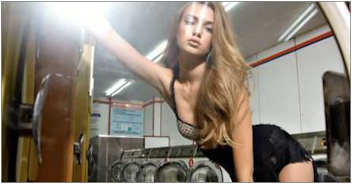
Thin’s Not in states a catwalk model. Only in New Zealand? Not quite, there is a trend in many countries to show off full figured women. Is it for you?

A recent study reveals even recently made digital recordings are at risk of being lost! Newer optical recordings like CD’s and DVD’s can start to lose their data as early as 3-5 years, while older magnetic tape has lasted over a century. Others such as recordings from Duke Ellington and Bing Crosby have already been lost. It takes a lot of money to preserve these recordings and without financial incentive historical recordings are being lost at an increasing rate. Congress is even getting in on the act with a preservation law.

Readers Submissions *menu
Hi there Steve
After your call to arms last week I thought I would get off my bum send in a reader's submission.
Let me introduce myself! I’m a very amateur photographer, no sorry, that is an exaggeration! I’m a busted arse miner from Australia that likes to take a few pics.
I had a few workshops with Steve that have been great. The best part being the help he has given me since. I have sent him multiple emails on a broad range of topics that he has always responded to.
These photos are from a very small town in Northern NSW Australia, Collarenebri. I had been to watch a big rugby league match in Brisbane, Queensland, known as State of Origin with 3 mates. The Aussies would know NSW got bashed & we stopped here on our way home staying with a friend. I had spent most of the night in the pub pictured below drowning my sorrows.
By some miracle I woke before sunrise which probably had something to do with the massive hangover. I trotted out hoping to get some great photos of the sunrise over the Barwon River. I ran outside in a drunken haze & got 50m down the Street before I noticed I was walking in the thickest of FOGS!!!
I marched on hoping the fog would lift before sunrise. I just happened to look back & see the streetscape behind me. It taught me a good lesson. Open my eyes have a good look at what is around. I was so set on a sunrise I nearly missed the best photos of the day.
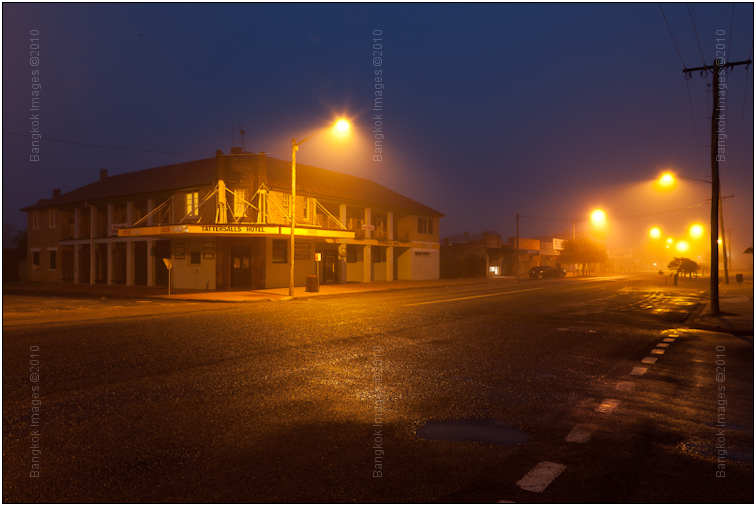
Canon 5D Mark ll, 24-105mm F/4 IS USM @ F/14 30sec 24mm ISO 100
The Tattersalls Pub, Collarenebri. A great pommy publican runs the place, worth a stop just to see the mighty Murray Cod on the wall behind the bar.
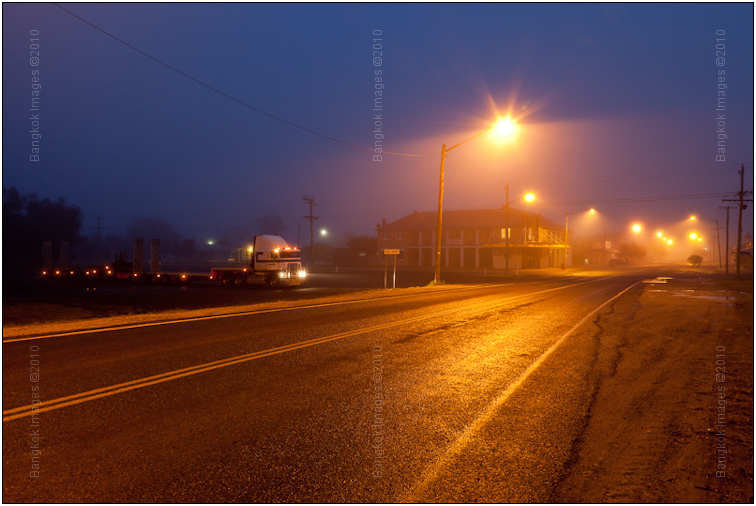
Canon 5d Mark II, 24-105mm F/4 IS USM @F/14 15sec 24mm ISO 100
Collarenebri. This photo probably shows 90% of the street lights in town. According to Wikipedia the population is 478.
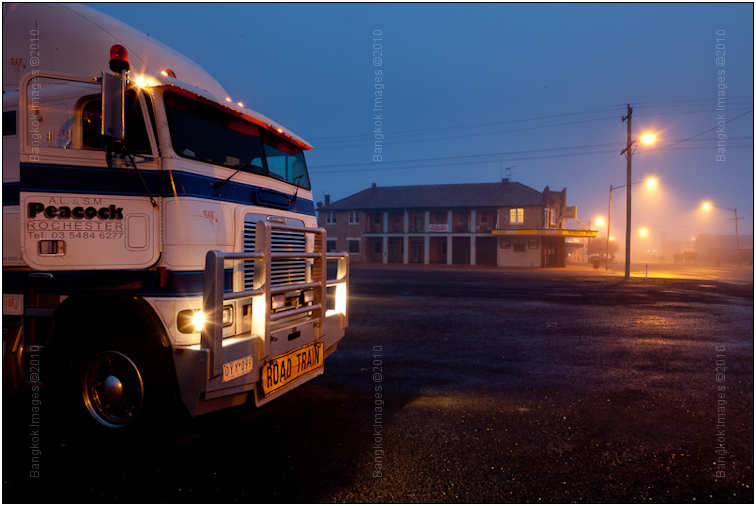
Canon 5D Mark ll, 24-105mm F/4 IS USM @ F/18 25sec 24mm ISO 100
Road Train. A part of outback Australia these trucks sometimes tow as many as 4 trailers in NSW they only pull 2. They take a while to get around when overtaking.
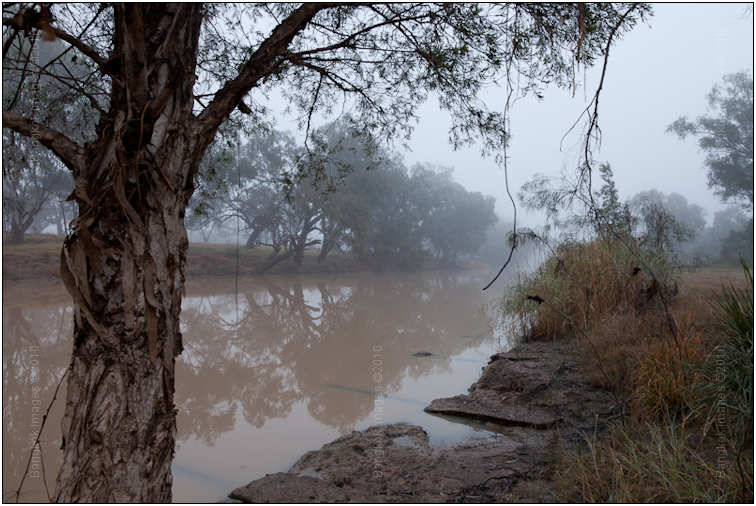
Canon 5D Mark II, 24-105mm F/4 IS USM @F/14 10sec 24mm ISO 100
The Barwon River. The Murray Darling Basin is the major river system in Australia and the Barwon is a major tributary, but to you over in the South East Asia I know it looks like a creek. It helps to illustrate Australia as the driest continent.
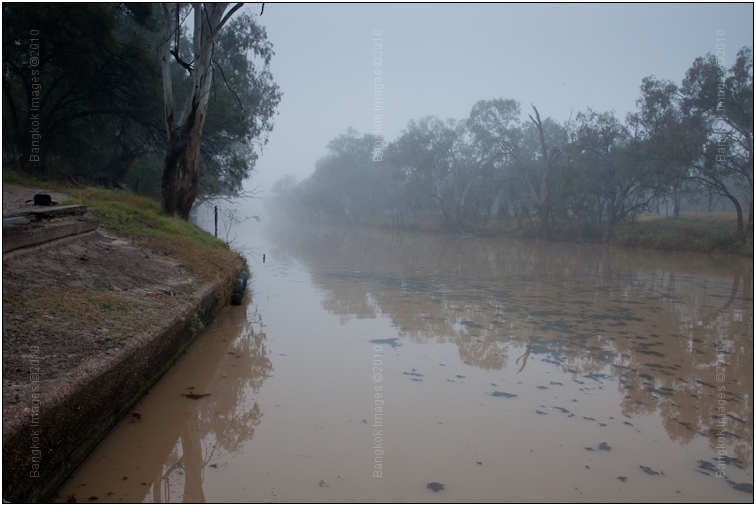
Canon 5D Mark II, 24-105mm F/4 IS USM @F/14 1/8sec 28mm ISO 100
SUNRISE ON THE BARWON!!!!! The fog didn’t lift until 10AM!!!! So much for the sunrise pics. Also take note of the professional placement of the camera bag. I’ve got a lot to learn.
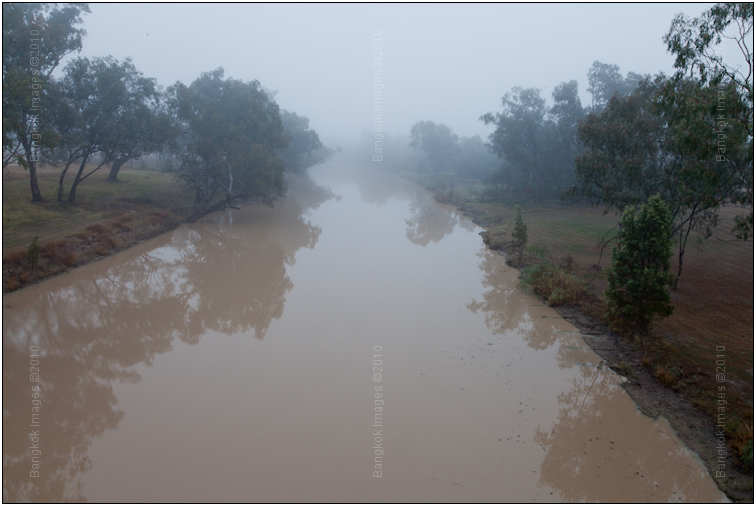
Canon 5D Mark II, 24-105mm F/4 IS USM @F/14 3.2sec 24mm ISO 100
The Barwon River from the bridge. Yes it’s an ugly brown muddy river but at different times you can get beautiful reflections making great shots. This was my hope. One day I’ll get a great sunrise with the reflection of the river gums overhanging the river. Just not this day.
That’s all from Oz for now
Cheers Rod
Rod –
Great submission! This is what people want to see and read. You’ve made my week. Thank you!
Steve
I suspect the readers' submissions will be a highly anticipated section of this column and I encourage anyone with photographs and travel accounts they'd like to share to please send them to me at: info@BangkokImages.com
Readers Questions *menu
Rod tells me about his new monitors.
On a photography front, I ended up getting 2 Dell u2711’s that I love. I’m waiting on an Xrite Color checker Passport & an xrite eye-one i1display 2 colour profiler. I also took the plunge and bought an NEX-5 and Canon 85mm f/1.2.
My Reply:
Sounds nice. You won’t have any problems color profiling two U2711’s (they use the video card LUT’s) because you have two video cards.. your only problem will be choosing which color profile you want to use. Every other purpose will be a compromise. Let me give you an example. I have 5 major profiles I use:
- sRGB for the web. I want to process an image and have it appear 100% on the web, as I see it in Lightroom or Photoshop. This means other people as well can see it the way you desire, because sRGB is the web standard. This includes shops that make your prints. Also, when set to this standard it allows you to see the work of others on the web as they designed it to be.
- CYMK I use this for processing images used for advertising brochures and the such. We call it pre-press.
- In house printing. Here, I use the full color gamut with my own in house printers. I want to be able to see output from my printer that looks exactly as it does in Lightroom or Photoshop. This means the monitor will usually be very dim compared to sRGB, which means I’ll need to increase the exposure relative to sRGB to get correct prints. If I sent out these files to an out of house printer who’s set up for sRGB.. they’d not only turn out underexposed, but the colors would be off.
- Out of house specialty wide-gamut printing. This is a profile for when I want to process my images in Lightroom or Photoshop, at their widest possible gamut, and then pay a specialty print house who uses wide-gamut inkjet art printers. This type of file printed on an sRGB printer, or viewed on an sRGB monitor.. will look severely oversaturated.. especially in the reds.
- And finally.. I want a profile less bright than standard sRGB but where the colors still look correct.. for my every day web viewing.
This is five profiles. With the NEC’s I can profile each of these on each monitor using my calibration software and hardware (in this case Spectraview II), and because the NEC’s use 12-14 bit hardware LUT’s, I can switch between them with the click of a mouse.
In contrast, your U2711’s use 8 bit video card LUT’s (the difference between 8 and 12 bits is a few million shades of color).. This means when you profile your monitor, you’ll have to choose a single purpose, and during the calibration process you’ll need to manipulate the monitor controls (brightness, contrast, red, green, blue) on the monitor itself.. so the monitor will be set up to work ONLY with that one profile. I did it this way for years.. and I learned that if I was profiled for one, I could get close to the others by upping/lowering the exposure, or increasing/decreasing colors.. but it was always a guess.. and I NEVER got the web part right..
So.. while the U2711’s are S-IPS quality monitors.. they lack this major ability photographers really need. I’ve only been fortunate enough to have this capability since I’ve had my new NEC’s.. but it’s like someone took the handcuffs off.. and I’m now 100% accurate on all profiles.. and I can do one kind of work now, ten minutes later another kind of work, and so on.. with no penalty. It’s great..
Please submit your questions to info@BangkokImages.com All questions will be answered and most will show up in the weekly column.
A Snapshot of Bangkok Images Week in Review *menu

This week there was a single workshop, and a ton of work on the website. We’ve finally sorted out the site galleries and user galleries so I hope to see some of your images posted soon. We’re also working on some big changes for the site, if I can make them happen I’ll be sharing the improvements with you soon. You’ve probably noticed we’ve been information side panels at strategic locations that actually make sense. These include exchange rate and weather widgets! The changes I want aren’t standard and require working with the blog and gallery developers, so let’s hope for the best. So far they’ve been very helpful and even enthusiastic concerning my requests.
But most of all, I’ve spent a load of time processing images from the last few trips. I’ll be posting some new galleries soon. They’re actually already up, but if you look at them now it will spoil the next few weeks columns, so I won’t be posting the links until then.
The “What’s New” area of our site continues to grow in popularity and the numbers are growing every week. The forums could use more activity, so if you want to meet more like minded photographers or just ask a question check them out. We’ve been updating the What’s New page several times a week and provide either an interesting new image or something of interest. Check it out to keep track of Bangkok Images exploits and commentary throughout the week.
Still a ton of hardware and software reviews being formed Please be patient, we have a lot coming and only so much space in the column each week to post it.
I’m very pleased to say my new budget monitor will work out nicely. Its only about 5-6 pounds and 1 inch thick with the stand detached, so it will travel with me on the road, and the image quality is quite good. I’ll be wrote a first look
in this weeks column, next week we'll define color profiling and the different types of monitors as they relate to profiling and photography uses, then we'll review the NEC LCD2690uxi2's, and finally wrap up the series with a good
look at laptop monitors. We also have a long promised review pieces of new hardware and software. It’s mostly a matter of priorities and space. But we’ll get to everything sooner or later.
Infocus Blog, Sub-30 And Dropping Fast! *menu
You know I’m not talking about the temperature. I’m talking about the exchange rate of the baht to the dollar. Today, September 30, 2010 marks the first time since July 16th, 2007 that the Thai baht dipped down below 30 (to 29.85) since July 2nd of 1997 as the baht soared from the historical lows in the 20-25 baht range of the early 1990’s, to over 56.1 on Jan 12th 1998 after the Thai economic crash of 1997.
From there it began a slow decent back into the 40’s which we enjoyed for the next year (1999) before it was back in the high 30’s, where it stayed until June of 2000 where it once again broke 40 and stayed there until mid-2006
when we started the sharp decent into the 30’s ending today, September 30th 2010 under 30 at 29.99 Thai baht to the US Dollar.
As many western currencies and some Asian currencies are pegged to the US Dollar we can assume expatriates from other countries have seen a decrease in their spending power as well. The big question everyone is asking is how low will it go, and when can
we expect to see a return to more reasonable exchange rates?
It depends who you listen to. With the Thai economy soaring at 7-8% a year and other Southeast Asian economies following right along, and our deficit ridden western countries not doing nearly as well, some are predicting exchange rates in the low-20’s
which we haven’t seen since the late 70’s. 25 doesn’t seen that unreasonable by this time next year.
Ultimately what this means for expatriates living off western based retirements and annuities is a sharp decrease in their standard of living IF they choose to stay in Thailand. The exodus started several years ago with many Brits choosing to return home,
and now Americans are feeling the pinch and have been leaving as well.
Other factors such as historically low home prices and mortgage rates back in the west contribute to the expatriates decision to return home and get in on the low prices and low interest rates while it’s still possible.
Everyone’s situation is different. I’ve always felt the psychological impact of 30 would be the deciding point for many and I still think it is. It’s where I set my
personal limit in 2004 which I’ve since reevaluated. I won’t be leaving Thailand for financial reasons unless the baht drops below 15. If I leave, it will be for the rewards of family or the pursuit of my career and not because the
exchange rate has become too dire.
Five years ago I wasn’t on the same financial footing that I am today, so my decision would have been different. What about you? What’s your number before you pack up and return to your home country, or perhaps another SEA country with a
more promising standard of living for your personal income?
I have a different view on Thailand’s economy than most. My feeling is there are undercurrents of Thailand’s power brokers over extending, trying to artificially compensate for the effect the downturn of the global economy should have had
on Thailand. Meanwhile, big business is pushing for rapid expansion where perhaps caution is better exercised. My personal feeling is a re-run of the 1997 crash is entirely possible in the next 20-24 months.
Am I right? Only time will tell either way. The trick to surviving or even taking advantage of whatever future economy we are certain to have, is to not repeat the mistakes of those who have failed before us. Be cautious, maintain an overly generous cushion,
study and monitor trends, and don’t hesitate long hoping a bad situation will get better. Set your limits and then be true to them. You can always return when things improve.
Until Next Time..




